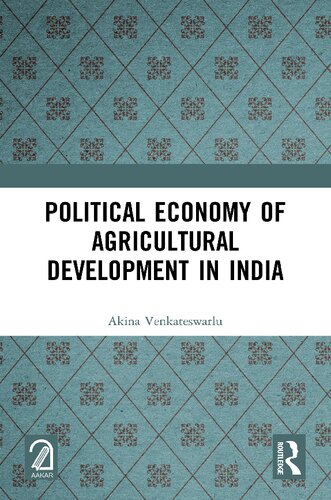

Most ebook files are in PDF format, so you can easily read them using various software such as Foxit Reader or directly on the Google Chrome browser.
Some ebook files are released by publishers in other formats such as .awz, .mobi, .epub, .fb2, etc. You may need to install specific software to read these formats on mobile/PC, such as Calibre.
Please read the tutorial at this link: https://ebookbell.com/faq
We offer FREE conversion to the popular formats you request; however, this may take some time. Therefore, right after payment, please email us, and we will try to provide the service as quickly as possible.
For some exceptional file formats or broken links (if any), please refrain from opening any disputes. Instead, email us first, and we will try to assist within a maximum of 6 hours.
EbookBell Team

5.0
38 reviewsThe book covers Indian agricultural development from the colonial to the present period. It examines how ruling class political ideology determined the agricultural policies from colonial rule. It considers both quantitative and qualitative aspects in all periods: colonial period to pre-green revolution phase, post-green revolution phase (early and late stages) and post-globalisation phase after 1991. India has achieved the ability to maintain food security, through enough food grain buffer stocks to meet the enormous public distribution system. But, with India’s entry into WTO in 1994, euphoria has been created among all types of farmers to adopt commercial crops like cotton cost-intensive inputs. Even food grain crops are grown through use of costly irrigation and chemicalised inputs. But they lacked remunerative prices, and so farmers began to commit suicides, which crossed 3.5 lakh. Government of India attributed this agrarian crisis to the technology fatigue and gave scope for second green revolution (GR-II). GR-I was achieved by public sector enterprise, whereas the GR-II as gene revolution is a result of private sector enterprise/MNCs. There is fear that opening up of the sector may lead to handover of the family farms to big agri-multinationals. GOI’s proposal to double farmers’ income by 2022 is feasible only when the problems, being faced by small, marginal and tenant farmers, are addressed in agricultural marketing, credit and extension services. Now, it is time to go for suitable forms of cooperative/collective agriculture, as 85 percent of total cultivators are the small and marginal farmers.
Please note: Taylor & Francis does not sell or distribute the Hardback in India, Pakistan, Nepal, Bhutan, Bangladesh and Sri Lanka.